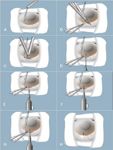Article
Implant causes minimal capsular fibrosis
A newly designed glaucoma shunt made of poly(styrene-b-isobutylene-b-styrene) (SIBS) is clinically biocompatible in the rabbit model and maintained 100% patency at 6 months after insertion. Histologically, minimal capsule fibrosis and minimal collagen deposits were observed around the implant. The most remarkable difference was the absence of myofibroblasts in the surrounding tissue in the SIBS group when compared with tubes made of silicone.

Key Points
Miami-A novel glaucoma implant (Miami-InnFocus Drainage Implant [MIDI], InnFocus LLC), seems to be clinically biocompatible in normal rabbits and maintained 100% patency 6 months after insertion, according to Ana C. Acosta, MD.
The implant, made of poly(styrene-b-isobutylene-b-styrene) (SIBS), was compared with a silicone rubber implant that was implanted in rabbit eyes. Minimal capsular fibrosis and minimal collagen deposits were found around the implant. Most importantly, no myofibroblasts were seen in the tissue around the SIBS device.

The implant design-that is, the shape, flexibility, and texture-could cause erosion, extrusion, inflammation, and scarring.
"Selecting a biomaterial and a design that produce a minimal inflammatory reaction and fibrosis may increase the rate of success," she explained. The investigators chose SIBS for this study because of its biostability and biocompatibility.
The investigators liked this material because it offers several advantages. "SIBS has excellent biostability because it has no hydrolysable or oxidizable groups on its backbone or on side groups," Dr. Acosta said. "The lack of biodegradation byproducts is believed to be a major factor enhancing its biocompatibility. In addition, SIBS can be loaded with different pharmaceutical agents. These unique material properties of SIBS are crucial for the fabrication of long-lasting implants."
In this comparative study, the SIBS implant was compared with another implant made of silicone rubber (PDMS). Both implants were extruded into tubes. The SIBS implant, a tube measuring 11 mm long with an inner diameter of 65 ± 10 μm, was implanted in 16 eyes of New Zealand white rabbits. The silicone implant, with an inner diameter of 300 μm, was inserted in a control group of nine rabbit eyes.
Surgical technique
Newsletter
Don’t miss out—get Ophthalmology Times updates on the latest clinical advancements and expert interviews, straight to your inbox.




